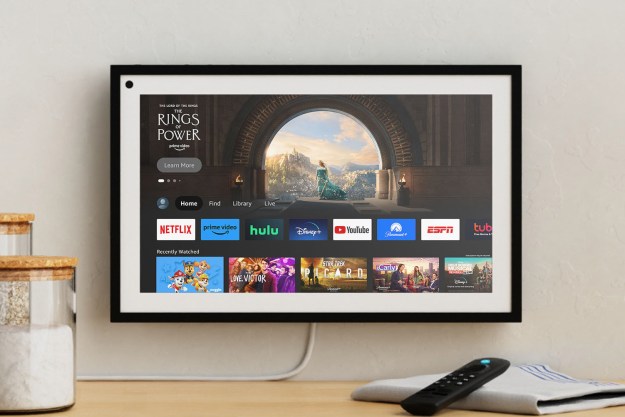Smart home robotics is a burgeoning field, and it’s no surprise that it’s a space ripe for disruption.
Mayfield Robotics, an independent subsidiary of appliance company Bosch, unveiled the Kuri at the Consumer Electronics Show on Tuesday. The 20-inch-tall, 12-inch-wide home robot is packed to the brim with technologies like asynchronous motors, a capacitive touch sensor, microphones, speakers, and an HD camera. But Kuri is a little more amiable than your average robot. It animates playfully when you call its name. It emotes audibly when instructed to perform a task. And a built-in LED changes color to indicate its current state of mood.
Mayfield sought to build a robot that’d feel less like a piece of technology and more like a “companion” — a point Chris Matthews, Mayfield’s vice president of marketing, emphasized in a sit-down at Digital Trends’ New York office in November. “It doesn’t feel like a robot in the traditional sense. It connects to people a different way than normal tech,” Matthews said. “It’s very much about what people feel.”
Mayfield’s humanistic approach to design is the result of exhaustive research. The company, the first Bosch spinoff founded outside of its home country of Germany, was founded with a two-pronged mission — to investigate the home robotics space, and to apply what it learned toward the development of its own product.

The Redwood City, California-based team got to work quickly. Mayfield’s six employees — two former Bosch roboticists, a CEO, and software engineers — built a home robot from the ground up, focusing on three pillars: mobility, awareness, and personality.
To those ends, the company designed Kuri with the ability to express human-like emotions. They eschewed a screen, instead opting for an animated spherical “head” and “eyelids” — articulated plastic frames over the robot’s “eyes” — that rely on a vertical lift and six motors. And they engineered a high-definition camera capable of “remembering” people the robot’s seen.
But the Kuri won’t be mistaken for a human anytime soon. The diminutive robot responds with chirps and squawks instead of human speech, a limitation of its underlying technology. “As soon as it starts talking and responding to a human voice, the level of expectation goes up,” Matthews said.
Those sounds are driven by dual speakers, which can also serve as a Bluetooth-connected speaker. Kuri’s primary interface, voice recognition, is enabled by a dedicated processor and 4-microphone array that responds to a wake phrase — “Hey Kuri” — and 12 other basic commands.
Voice recognition dovetails with Kuri’s ability to “recall” its surroundings. Thanks to a laser-depth system that tracks the location of walls and furniture at the millimeter level, Kuri is able to build a digital, room-by-room map of its surrounding environment. And real-time tracking prevents it from colliding with objects in its way.
In a demo at the Consumer Electronics Show, Matthews instructed a Kuri unit to travel from a hotel suite kitchen to a living room with a verbal command, and then placed a backpack in its path. The robot identified the bag en route and slowly, cautiously moved around it.
Small electric motors power Kuri’s movement. The two large castor wheels — big enough to handle flooring, carpets, leather, area rugs, and transitions between them, according to Matthews — are the result of years of engineering. The first few prototypes featured four-wheel drive and used spheres as drive wheels, a combination that led to instability issues. “It basically fell over on its side,” Matthews said.
Kuri isn’t entirely autonomous. All of the robot’s functions can be remotely controlled via a smartphone companion app: its motors via a virtual trackpad, its speakers through the smartphone’s microphone, and its camera via a dedicated “record” button. And most of that content is stored for later perusal on Mayfield’s cloud storage. “You’ll be able to see wherever Kuri’s been some number of days,” Matthews said, “and save and share your favorite moments.”
What the Kuri has in hardware and software, though, it unfortunately lacks in third-party support. It’ll interface with If This Then That (IFTT), a web-based service that allows users to link disparate internet-connected services and hardware such as Gmail, Facebook, Instagram, Google Home, and Logitech’s Harmony Hub. And it’ll launch without smart home partnerships with platforms like like SmartThings and Philips Hue.
“We want to ship a complete product — one that’s useful for everybody. We’ll keep making it better,” Matthews said. “We want to build robots that are joyful, useful, and inspiring. Kuri moves, listens, sees, speaks, and entertains. We worked hard to make sure we were hitting on those three chords.”
Mayfield Robotics is ensuring a level of development transparency. Starting Wednesday, it’s embarking on a yearlong development process that’ll see the Kuri’s software and hardware improve weekly. The research team will post regular updates on progress, and solicit feedback from both customers and the broader public.
Kuri is available for pre-order starting Wednesday at HeyKuri.com with a $100 deposit. It’ll retail for $700 next year, and ship with a dedicated charging dock.
Editors' Recommendations
- Roborock S8 MaxV Ultra vs. Ecovacs Deebot X2 Combo: Which premium robot vacuum is best?
- iRobot Roomba Combo j9+ vs. iRobot Roomba Combo Essential: Which is better for you?
- Roborock S8 MaxV Ultra vs. Roborock S8 Max Ultra: Which is the better robot vacuum?
- Roborock S8 MaxV Ultra vs. Roborock S8 Pro Ultra: Which is the best robot vacuum?
- Home Depot’s Hubspace is a great way to start building your smart home


